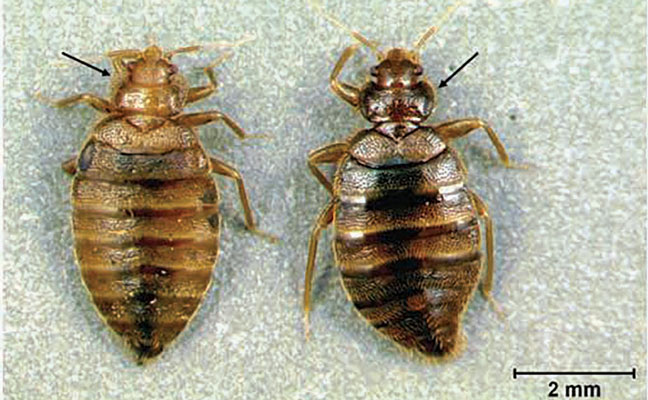
Note the difference in the prothorax on the common bed bug, left, and on the tropical bed bug, right. This photo is from a 2016 research paper about the tropical species, available to read online at Tinyurl.com/2pp9ny8m. PHOTO: DR. BRITTANY CAMPBELL, BCE
In honor of the National Pest Management Association’s PestWorld 2023 conference and trade show taking place in Honolulu, Hawaii, let’s take a quick look at the tropical bed bug. It shares a genus with the common bed bug (C. lectularius), and its habits are similar as far as being a parasite of humans. In regions where both species exist — Hawaii included — they both may be present within an infestation.
However, tropical bed bugs require a higher average temperature than the common bed bug to thrive.
Florida, which did not see tropical bed bugs after the late 1930s thanks to the popularity of pesticides like dichlorodiphenyltrichloroethane (DDT), saw a resurgence in the species around 2015.
Not as much research has gone on for C. hemipterus as for its more common cousin, but most currently available bed bug products are appropriate for both species, and the bugs have similar physiological reactions to physical control, chemical control and preventive methods.
Biology and behavior
C. lectularius has a broader prothorax (front of the middle part of the body) than C. hemipterus. Also, its thorax (chest area) extends like flattened “wings” upward toward the head in the common bed bug. Otherwise, the differences between the species are minute enough that they cannot usually be detected without a microscope.
Both species rest and breed in the cracks and crevices of walls and furniture in human habitations, emerging at night to feed on their sleeping hosts. Neither species is of medical importance as far as being disease vectors, but their bite can be itchy, painful and a general nuisance to humans.
An integrated approach
As with any integrated pest management (IPM) strategy, educating clients about bed bugs and what they need to do to assist and ensure control is key. It’s a good idea to take your clients with you on a visual inspection. Document your findings, and have them sign off on the inspection. Be candid about what to expect from the control program, and document expectations.
You also should develop a detailed contract specific to the treatment situation. Provide clients with written instructions on preparing for treatment.
Keep your technicians up-to-date on both bed bug basics and the latest research and techniques. Use all available control and prevention methods as appropriate, as certain situations will require different approaches. Do not try to force a cookie-cutter approach. Lastly, follow up regularly with clients to ensure there are no reinfestations.
REFERENCES
- CMS.ctahr.hawaii.edu/jwtay/Pest-info/Bed-Bugs, accessed August 2023
- ScienceDirect.com/topics/agricultural-and-biological-sciences/cimex-hemipterus, accessed August 2023
- Truman’s Scientific Guide to Pest Management Operations, Seventh Edition, available for purchase at MyPMP.net/shop
Leave A Comment